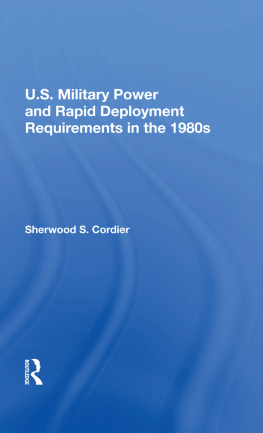U.S. Military Power and Rapid Deployment Requirements in the 1980s
Westview Replica Editions
The concept of Westview Replica Editions is a response to the continuing crisis in academic and informational publishing. Library budgets for books have been severely curtailed. Ever larger portions of general library budgets are being diverted from the purchase of books and used for data banks, computers, micromedia, and other methods of information retrieval. Interlibrary loan structures further reduce the edition sizes required to satisfy the needs of the scholarly community. Economic pressures on the university presses and the few private scholarly publishing companies have severely limited the capacity of the industry to properly serve the academic and research communities. As a result, many manuscripts dealing with important subjects, often representing the highest level of scholarship, are no longer economically viable publishing projects--or, if accepted for publication, are typically subject to lead times ranging from one to three years.
Westview Replica Editions are our practical solution to the problem. We accept a manuscript in camera-ready form, typed according to our specifications, and move it immediately into the production process. As always, the selection criteria include the importance of the subject, the works contribution to scholarship, and its insight, originality of thought, and excellence of exposition. The responsibility for editing and proofreading lies with the author or sponsoring institution. We prepare chapter headings and display pages, file for copyright, and obtain Library of Congress Cataloging in Publication Data. A detailed manual contains simple instructions for preparing the final typescript, and our editorial staff is always available to answer questions.
The end result is a book printed on acid-free paper and bound in sturdy library-quality soft covers. We manufacture these books ourselves using equipment that does not require a lengthy make-ready process and that allows us to publish first editions of 300 to 600 copies and to reprint even smaller quantities as needed. Thus, we can produce Replica Editions quickly and can keep even very specialized books in print as long as there is a demand for them.
About the Book and Author
U.S. Military Power and Rapid Deployment Requirements in the 1980s
Sherwood S. Cordier
This book assesses U.S. military needs in the coming decade, focusing on the role of rapid deployment forces in protecting U.S. interests abroad. Dr. Cordier begins by discussing two general developments crucial to future military requirements: first, increasing U.S. dependence on the global sea-lanes as links to key markets; and second, improved Soviet naval, airborne, and sealift capabilities that allow the U.S.S.R. to play an intervention role in the Third World. Given these trends, the most serious U.S., military shortcoming, says Dr. Cordier, is in the area of rapid deployment requirements, particularly lack of sufficient means to transport troops by air and sea to major theaters around the world. Carrier-based airpower and the need for medium-sized aircraft carriers are especially crucial. The book concludes with specific policy recommendations designed to improve U.S. rapid deployment forces.
As an independent observer, Dr. Cordier finds a middle course between the policies of the Reagan administration and those of its opponents in Congress. Currently a professor of history at Western Michigan University, he is the author of The Air and Sea Lanes of the North Atlantic: Their Security in the 1980s.
First published 1983 by Westview Press
Published 2018 by Routledge
52 Vanderbilt Avenue, New York, NY 10017
2 Park Square, Milton Park, Abingdon, Oxon OX14 4RN
Routledge is an imprint of the Taylor & Francis Group, an informa business
Copyright 1983 by Taylor & Francis
All rights reserved. No part of this book may be reprinted or reproduced or utilised in any form or by any electronic, mechanical, or other means, now known or hereafter invented, including photocopying and recording, or in any information storage or retrieval system, without permission in writing from the publishers.
Notice:
Product or corporate names may be trademarks or registered trademarks, and are used only for identification and explanation without intent to infringe.
Library of Congress Catalog Card Number: 83-50065
ISBN 13: 978-0-367-21244-5 (hbk)
A leave of absence, granted by Western Michigan University, helped make this study possible. It is a pleasure to thank the Margaret Burnham Macmillan Fund and the Office of the Dean of the College of Arts and Sciences for partial financial assistance. The valuable services of a research assistant were underwritten by the Graduate College.
Valuable assistance in this study was provided by the Center for Naval Analyses and its Director, Bradford Dismukes. Discussions with Herschel Kanter, Colonel John R. Landry (USA), Michael MccGwire, Michael Moodie, Stephen E. Ockenden and Commander Bruce W. Watson (USN) proved stimulating and enlightening. Only the author, of course, is responsible for the data and views to be found in this volume.
The professional skills of Mrs. Judith Massie, who typed the manuscript, and Michael and Kimberly Winblad, who set the final copy by word processor, are warmly appreciated. I am grateful to my wife, Mary, whose encouragement and support during the throes of authorship have meant so much.
Sherwood S. Cordier
March 1983
I
Introduction
The naval forces of the United States are now at a crucial juncture in their historical development. A host of problems have sapped the strength of the fleet that ruled supreme over the oceans of the world in the era following the Second World War. Many ships of World War II vintage have been retired. Other warships, brought into service in the 1950s, will soon reach the end of their useful life. The lean budget years of the 1970s have failed to replace the numbers of ships and aircraft lost to the Navy. Naval operations are hamstrung by a dire shortage of highly skilled technicians and experienced non-commissioned officers.
However, while U.S. naval capabilities have considerably eroded, the responsibilities confronting the United States Navy have substantially increased. Seaborne trade, upon which the economy of the United States depends, has burgeoned. Dependence upon overseas sources of indispensable minerals has grown by a quantum degree. In the 1950s Russia possessed little more than a coastal defense fleet. Today the Soviet Union can boast a true high seas navy, capable of operating in any far flung corner of the world. However, as the Iranian Crisis and the Falkland Islands War clearly demonstrate, challenges other than Soviet abound in the world. The spread of massive quantities of sophisticated weaponry ensures that virtually all nations now enjoy substantial lethal arsenals. The predicament of the U.S. Navy is aptly summarized as a one and a half ocean fleet overstretched to cope with responsibilities in three oceans. However, American and western interests in such vital areas as Africa and the Middle East involve all of the armed forces of the United States and a wide range of military capabilities.
The Soviet Union has developed the doctrine, strategy, and forces appropriate to intervention in continents far from the Russian homeland. Key Soviet partners, notably Cuba and East Germany, furnish substantial contingents of troops and military specialists. In the course of the 1970s the Soviets have undertaken successful ventures in Africa and along the Indian Ocean. Again, however, Soviet and Cuban empire building are far from being the only threat to western interests. Internecine conflict among Third World nations and the internal fragility of vital oil and mineral producing regimes pose even graver problems for the United States and its allies. Such problems arise frequently, admit no simple solutions, and can be dauntingly intractable.










